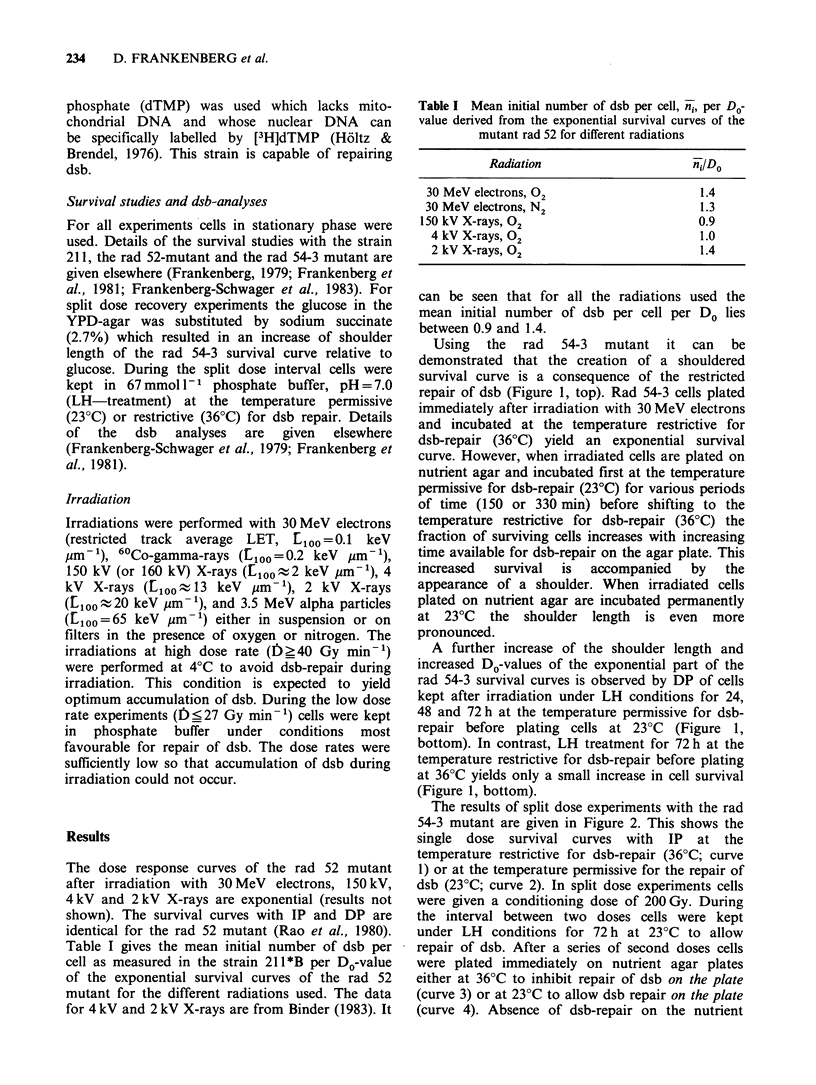Abstract
Evidence is presented that in yeast cells one DNA double-strand break (dsb) may be considered as one potentially lethal lesion (PLL). Using a temperature conditional radiosensitive diploid yeast mutant (rad 54-3) it is demonstrated that the shoulder of survival curves, for cells plated immediately, is due to repair of dsb (PLL) within a restricted time period. Split dose experiments with the mutant rad 54-3 show that the reappearance of a shoulder is observed when two conditions are met: (1) repair of dsb (PLL) during the time interval between doses and (2) repair of mainly those dsb (PLL) which are induced by the second dose on the nutrient agar plate. Irradiation of wild type yeast cells at high dose rate followed by liquid holding treatment for 72 h (delayed plating, DP) or at low dose rate show that the bending of DP-survival curves is due to the accumulation of dsb (PLL) leading to lethal lesions probably by misrepair of dsb.
Full text
PDF





Selected References
These references are in PubMed. This may not be the complete list of references from this article.
- Budd M., Mortimer R. K. Repair of double-strand breaks in a temperature conditional radiation-sensitive mutant of Saccharomyces cerevisiae. Mutat Res. 1982 Jan;103(1):19–24. doi: 10.1016/0165-7992(82)90080-x. [DOI] [PubMed] [Google Scholar]
- Frankenberg-Schwager M., Frankenberg D., Blöcher D., Adamczyk C. The influence of oxygen on the survival and yield of DNA double-strand breaks in irradiated yeast cells. Int J Radiat Biol Relat Stud Phys Chem Med. 1979 Sep;36(3):261–270. doi: 10.1080/09553007914551031. [DOI] [PubMed] [Google Scholar]
- Frankenberg D., Frankenberg-Schwager M., Blöcher D., Harbich R. Evidence for DNA double-strand breaks as the critical lesions in yeast cells irradiated with sparsely or densely ionizing radiation under oxic or anoxic conditions. Radiat Res. 1981 Dec;88(3):524–532. [PubMed] [Google Scholar]
- Frankenberg D., Frankenberg-Schwager M. Interpretation of the shoulder of dose-response curves with immediate plating in terms of repair of potentially lethal lesions during a restricted time period. Int J Radiat Biol Relat Stud Phys Chem Med. 1981 Jun;39(6):617–631. doi: 10.1080/09553008114550741. [DOI] [PubMed] [Google Scholar]
- Frankenberg D. Reparable and irreparable damage in yeast cells induced by sparsely ionizing radiation. Int J Radiat Biol Relat Stud Phys Chem Med. 1979 Oct;36(4):317–324. doi: 10.1080/09553007914551101. [DOI] [PubMed] [Google Scholar]
- Ho K. S. Induction of DNA double-strand breaks by X-rays in a radiosensitive strain of the yeast Saccharomyces cerevisiae. Mutat Res. 1975 Dec;30(3):327–334. [PubMed] [Google Scholar]
- Luchnik A. N., Glaser V. M., Shestakov S. V. Repair of DNA double-strand breaks requires two homologous DNA duplexes. Mol Biol Rep. 1977 Dec;3(6):437–442. doi: 10.1007/BF00808385. [DOI] [PubMed] [Google Scholar]
- Rao B. S., Reddy N. M., Madhvanath U. Gamma radiation response and recovery studies in radiation sensitive mutants of diploid yeast. Int J Radiat Biol Relat Stud Phys Chem Med. 1980 Jun;37(6):701–705. [PubMed] [Google Scholar]
- Resnick M. A., Martin P. The repair of double-strand breaks in the nuclear DNA of Saccharomyces cerevisiae and its genetic control. Mol Gen Genet. 1976 Jan 16;143(2):119–129. doi: 10.1007/BF00266917. [DOI] [PubMed] [Google Scholar]


